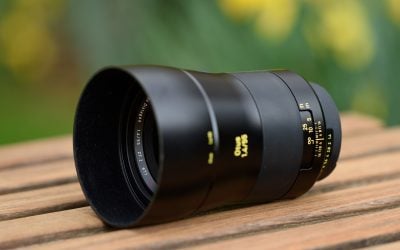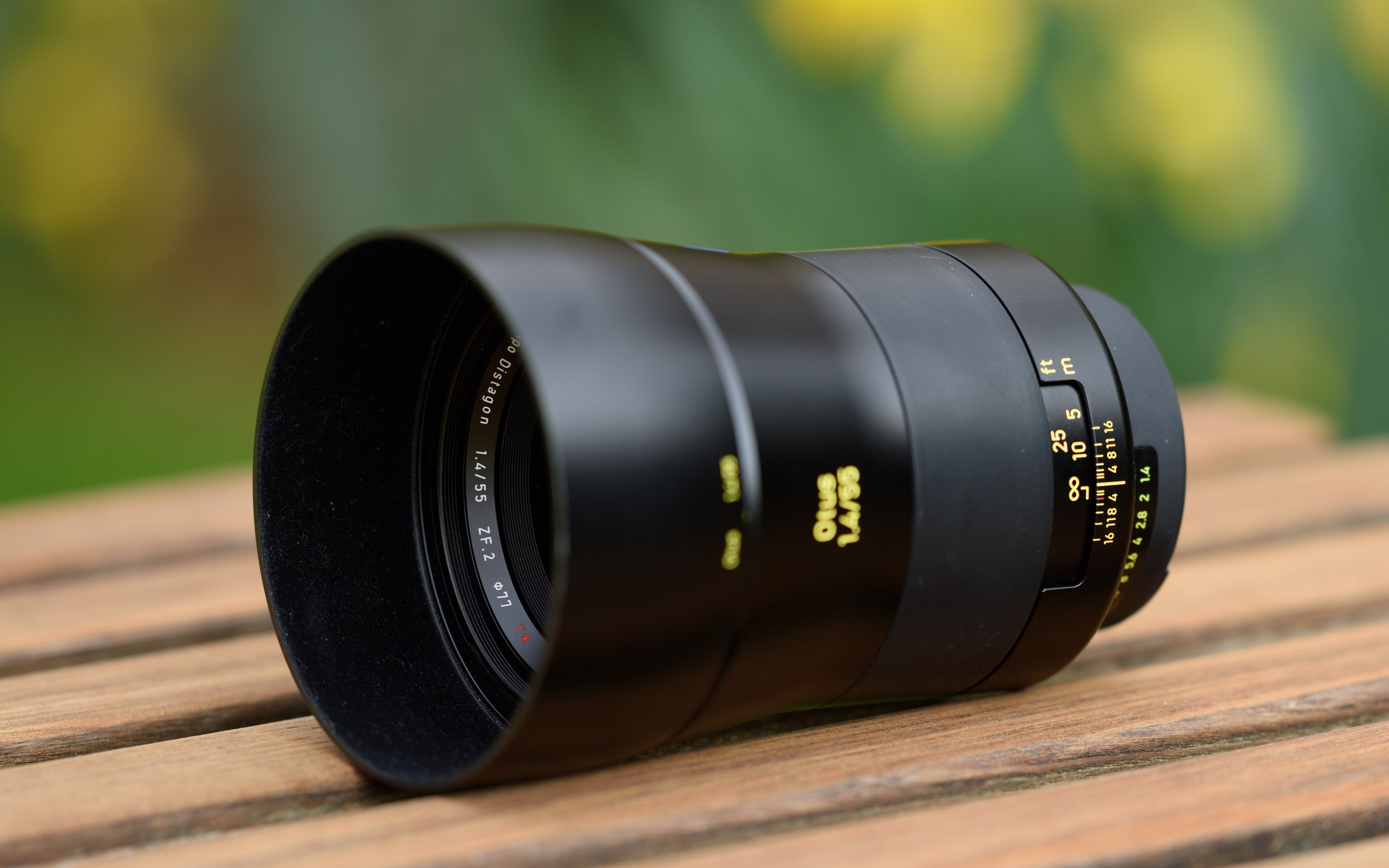
Zeiss Otus 55mm f1.4 review
-
-
Written by Thomas
Intro
The Zeiss 55mm f/1.4 Otus is a standard lens with ambitious goals and a price tag to match, claiming to offer ‘truly spectacular, world-class performance without compromise’. Announced in 2012, but only released in November 2013, it certainly took a long time to complete.
The Otus 1.4/55, as Zeiss refers to it, is actually the company’s third “standard” lens for full-frame sensors. It’s available with Canon mount “ZE” and with Nikon F-mount “ZF.2”, but can be used via adapters on other manufacturers’ bodies, such as the Sony A7 / A7r. And like all Zeiss lenses, excluding the Touits, it is manual focus only.
The lens goes head-to-head with the offerings from almost any camera maker: Nikon, Canon, Sony all have their own version of a 50mm lens with an aperture larger than f1.8, but none carry this kind of price tag nor describe themselves as being the absolute best lens in the World today. So the obvious question is just how good is it anyway? Can any standard lens justify a price of $4000 USD? In my Zeiss 55mm f1.4 review I’ll share my findings, including sharpness results, contra-light performance, Bokeh, and a selection of sample images when mounted on a demanding 36MP Nikon D800 body.
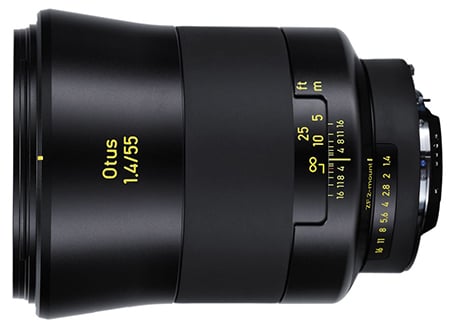 |
Facts from the catalog
As usual I’ll have a look at the technical data first – based on the Nikon ZF.2 version. I’ve rated the features with a [+] (or [++]), when it’s better than average or even state of the art, a [0] if it’s standard or just average, and [-] if there’s a disadvantage.
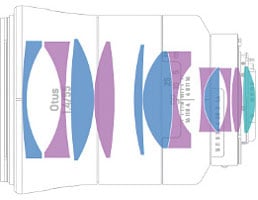 | |
Most features are compared to Nikon’s most recent AF-S 58/1.4G.
Size (diam. x length): 92 x 118 mm (3.6 x 4.6 in.). The lens-shade adds another 32mm to a total length of 150mm (5.9 in.). Much longer and bulkier than the 58/1.4G at 85 x 70 mm, more comparable to a 24-70/2.8 standard-zoom. [-]
Weight: at 970 g (34.2 oz) quite heavy. The 58/1.4G is only 385g. [-]
Optics: 12 lenses in 10 groups vs. 9 elements in 6 groups for the 58/1.4G. This is the most complex “normal” lens-design that I’ve seen. It looks more like a wide-angle and that is deliberately so: The designers said that they could control aberrations better with it than with the standard double Gaussian design of other normal lenses. But twenty glass/air-surfaces give a lot of opportunity for reflection. To avoid negative effects the coating better be good. [0]
Closest focus distance/max. magnification: 50 cm (1.6 ft.) / 1:6.8. Pretty much standard for “normal” lenses. The Nikon 58/1.4G offers 58 cm with slightly less magnification of 1:7.7. [0]
Filter-thread: 77mm = standard for many pro-lenses. [0]
Image stabilization: No, same as any other fixed focal large aperture lens from Nikon or third parties below 200mm focal length. [0]
AF: No! Manual-focus only. [-]
Covers full frame/FX or smaller = very good [+]
Price: around 3500 EUR new (incl. 19% VAT). Nikon’s 58/1.4 is at around half the price. [-]
Comes with no lens pouch but the lens-shade is included, reversible for transport, and the lens-caps are similar to Nikon’s. [-]
Distance information is not relayed to the camera, so some of the advanced exposure-related calculations that Nikon bodies can do (e.g. while using a flash) do not work with this lens. [-]
Aperture ring = yes (Nikon ZF.2 version only), so you can control aperture from the lens just like in old times. [+]
Sealing: no rubber-grommet at the lens-mount. I asked Zeiss about their lens being “hardened” for the elements. They replied that the enclosure of the optical groups effectively seals the lens against dust and moisture. [0]
The score in the “features-department” is 6[-]/5[0]/2[+]. On paper this looks like the worst lens I’ve ever tested: Much larger and heavier than the competition, no AF, no lens-pouch, no electronic distance information, and an exorbitant asking price; and if you buy the Canon version you don’t even get an aperture ring. That can only mean one thing: the optical performance of this lens better be outstanding, or no one will buy it.
Motivation
Well, 55mm is not called a “normal” lens (for full-frame bodies) for no good reason. Normal-lenses have a focal length that is close to the diagonal of the sensor (43mm for a FX-sensor). These lenses produce a life-like perspective and natural look when the images are also viewed from a distance that is equivalent to the diagonal of the print/monitor. But mind you: 55mm focal length on a full-frame/FX body is not considered long enough for a flattering perspective in head-shot type portraits. For that type of shot you better get an 85mm lens for your FX body. Of course when you mount a 55mm lens on a APS-C body it delivers a much more portrait-friendly 83mm equivalent.
The much coveted f1.4 aperture is 2/3 of a stop brighter than the cheaper f1.8 models and also gives you a larger blur-circle on all out-of-focus subjects. And if you chose to invest only in one f1.4 lens for your work the combination with 55mm focal length might be your best bet to get a good return on your investment.
Alternatives
The market for large aperture 50-58mm lenses is pretty crowded: every big camera manufacturer plus two other lens-manufacturers offer at least one f1.4 version. And there are a similar amount of 50mm f1.8 versions on offer that should also be considered as alternatives to a f1.4 lens: after all, they are smaller, lighter, cheaper, less obtrusive and often ofter similar image quality than their bigger brothers. The loss of 2/3 of a stop may not be as relevant as the marketing literature is wanting you to believe. But if you absolutely want f1.4 then you have the following alternatives:
– From Nikon there are the AF-S 50/1.4G (see my Nikon AF-S 50mm f/1.4G review) with a street price of around 300 EUR or the new and much more expensive 58/1.4G (see my Nikon AF-S 58mm f1.4G review).
– Canon offers the EF 50/1.4 USM plus the EF 50/1.2L USM (see Gordon’s Canon EF 50mm f1.2L USM review).
– Sony has the AF 50/1.4 and the AF 50/1.4 ZA SSM in the A mount.
– Sigma offers its Sigma AF 50/1.4 EX DG HSM at around 420 EUR which performs competitively to Nikon’s 50/1.4G (my review will soon follow). Plus Sigma announced a newly designed 50mm F1.4 DG HSM (more information here).
– There are also other manual focusing alternatives: the Zeiss ZF.2 Planar T* 50/1.4 at 600 EUR and the Voigtlander SL II Nokton 58/1.4 at 500 EUR. Both lenses perform very well in the image center according to reviews but the Zeiss seems very soft in the FX-corners and the Voigtlander produces a nervous Bokeh. Interestingly Samyang / Walimex does not offer an f1.4 lens yet with a focal length around 50mm.
Focus
Focus accuracy and repeatability is critical to consistently produce sharp shots, especially with large aperture primes. Now with a manual focus lens you might ask how to test this? Well, at first I thought I’d simply skip this chapter in my review but then I thought better of it: Why not make a similar test of my personal focus-abilities with this lens like I do with all auto-focus lenses and see how I can do compared to the results from an AF-lens. Sort of a man-vs-machine competition. Because to be honest: if I could not focus this lens properly hand-held through the optical viewfinder of my Nikon D800 I would never think of keeping it! Yes, there’s always the possibility to use live-view at large magnifications from a tripod (as I do with all shots from my results-page) but that would seriously limit the usefulness of this lens under real-life shooting conditions to me.
So I set up the same test-case with regard to target and lighting as with AF-lenses and did 20 shots each coming from infinity or from minimum focus distance and rated the results in 100% (!) view in my usual way. I tried not to take too long in acquiring focus so when I had the focus in the right ballpark I took about 1-2 seconds to fine-tune the result. My experience with manual focus was over 20 years ago, when I had my Olympus OM-2N film-body equipped with the standard viewfinder screen which had a split-prism in the center, a micro-prism ring around that and a thoroughly ground structure in the rest of the viewfinder area. I found it pretty simple to manually focus in these days and seldom lost shots due to mis-focus. But optical viewfinders in today’s DSLRs are built without regard for the need of manually focusing: the have no split prism or micro prisms and the transparency is much to high to judge sharpness (or dof by the way). There are replacement screens available that are much better suited for MF but unfortunately Nikon offers none of those. There are only third-party replacements available and it is up to your own good judgment whether you want to allow someone to do the replacement and warrant proper operation afterwards. E.g.: my preferred camera dealer in town does not offer such a replacement. So the results from my tests with the Zeiss Otus rely solely on the built-in standard viewfinder screen of the D800 and the focus indicator which shows a solid green dot if focus is acquired or an arrow to indicate how to turn the focus ring to achieve focus. Btw.: The Zeiss Otus is fortunately built to match the standard focus direction of either Nikon (turn left to focus closer) or Canon (turns right): Very convenient!
Here are the results from my testing: of 40 shots manually focused there were 11 shots with excellent sharpness and 8 shots with very good sharpness. So almost half of the shots were perfect keepers. Another 14 shots were acceptable and 7 shots (almost 20%) were what I call “outliers”. Compare this with the results from the Nikon AF-S 58mm f1.4G where 70% of the shots produces excellent focus and 30% very good and thus 100% of the shots were perfect keepers.
There you have it: manual focus is bad for your image quality, or at least mine. And with a 50% chance to get less than desirable sharpness this certainly is the end for many considering this lens. It was not the end for me though. Why? First, my style of shooting allows for checking for sharpness after the shot in the field and re-trying if the results are not to my satisfaction. Second, I learned that I have a learning curve for manual focusing and interpreting the focus-indicator that should increase my chances for success when using the lens more often. Here “interpreting the focus-indicator” needs some further explanation. Have a look at following images:
Zeiss Otus 55mm f/1.4 at f1.4 manual focus with Nikon D800 focus-indicator | ||
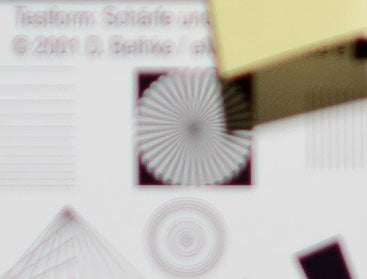 | 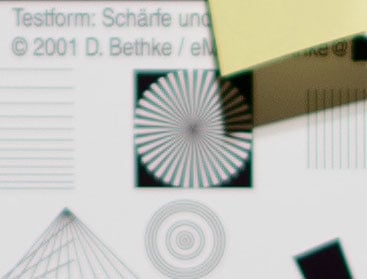 | |
| coming from infinity, 100% crop | coming from minimum focus distance, 100% crop | |
The left image resulted from slowly turning the focus ring from infinity until the focus-indicator first lit up indicating “in focus”. The right image resulted from the same procedure but coming from minimum focus distance. Both images show that the focus-indicator of the Nikon D800 has a pretty broad range in which it lights up. So to make the best use of it you need to find the “middle” of this range. Then, with a little practice it works quite well.
Another thing I found about manual focusing: When you check on the sharpness of a shot and find you need to readjust focus a bit I found the large distance scale (plus the long throw) and the dof markers on the Otus really helpful.
Distance scale and dof markings of Nikon 50mm f/1.4G vs. Zeiss 55mm f1.4 Otus |
 |
| left Nikon, right Zeiss |
You can observe two things here: (1) readability of the scales on the Otus is so much better because it’s larger, clearer and not hidden behind a plastic window and (2) the spread of the scales makes them much more useful. Does this have any relevance in practice? Yes, it really does make a difference! I found out that oftentimes after viewing a shot with less than perfect focus I could adjust focus by using the dof and distance scales and my “gut-feeling” and nail the shot or at least get very close. Not sure where this came from, because I’ve never done that in the past, but it certainly depends on the clear indication the scales give about dof and the large throw of the focus ring.
So here is my strong recommendation derived from over 1000 shots: if you can’t manage to properly focus manually you better forget about this lens, skip this review to avoid being infected by the BIQ-virus (Best Image Quality) and head over to alternative normal lenses that offer autofocus. But if your shooting style allows for taking a second or third shot to nail focus properly then chances are that the Zeiss Otus is one of the most accommodating lenses for the intricacies of manual focus. And to be honest: Even with all the auto-focus lenses I use I almost always check for perfect focus, because with less than ideal targets there’s always a chance the camera pulled focus to a different spot than you intended it to.
The focus ring has no slack/play between its movement and the focus-action and a throw of around 250 degrees, which is the largest throw I ever saw on any lens, even macro-lenses; for the record, the Nikon 58/1.4G turns 100 degrees. This is ideal for accurate focus wide open although you need to get used to the amount of movement that is needed to acquire focus. The focus ring is easy to grip even with gloves although it has no structure. It moves very smoothly and can be operated with one finger. It has hard stops on both sides of the distance scale so you know exactly when you’ve reached one or the other end of the focus range. But the hard stop on the far end is a bit beyond infinity so you star-gazing photogs still need to find exact focus manually if you want to capture the Milky Way in all its sparkling glory. And what’s more interesting for videographers: Focus breathing is visible i.e. things in the background become larger the closer you focus. It’s comparable to the focus-breathing of the Nikon 58/1.4G and I’d rate the effect pretty harmless.
Note an increasing number of cameras are offering manual focusing aids that go beyond a magnified view in Live View. Most notably, focus peaking will outline a subject that’s in focus with a coloured fringe which, coupled with magnified assistance, can really help you nail a shot in manual focus. Gordon plans on discussing this further in an update after spending some time with the Otus on a Sony A7r – watch this space!
Build quality
The lens has nine rounded aperture blades and the aperture ring has half-stop clicks up to f11, although there’s no smooth step-less option that videographers would have liked. To operate the aperture from the camera simply set it to f16 where it is automatically arrested with a small latch/button. The lens is built like a tank with a fully metal outer barrel, metal innards, and a metal lens-shade that fits seamlessly at the lens-front and does not rattle. This full-metal build is frowned upon by some fearing problems at sub-zero temperatures. Well, I tested the lens coming from a night in the deep-freezer and neither did my naked fingers stick to the cold metal surface nor did the focus-action become too stiff. Operating this lens at -22 degrees Celsius (-8 degrees Fahrenheit) was no problem at all.
The design is gently curved even with the lens-shade attached and the surfaces are all smooth and easy to clean. All-in-all holding and operating this lens conveys a feeling of great craftsmanship and solid high-quality build that exceeds any lens I’ve ever touched.
Now it’s time to check out some results in my Zeiss Otus 55mm f1.4 quality and Zeiss Otus 55mm f1.4 sample images pages!
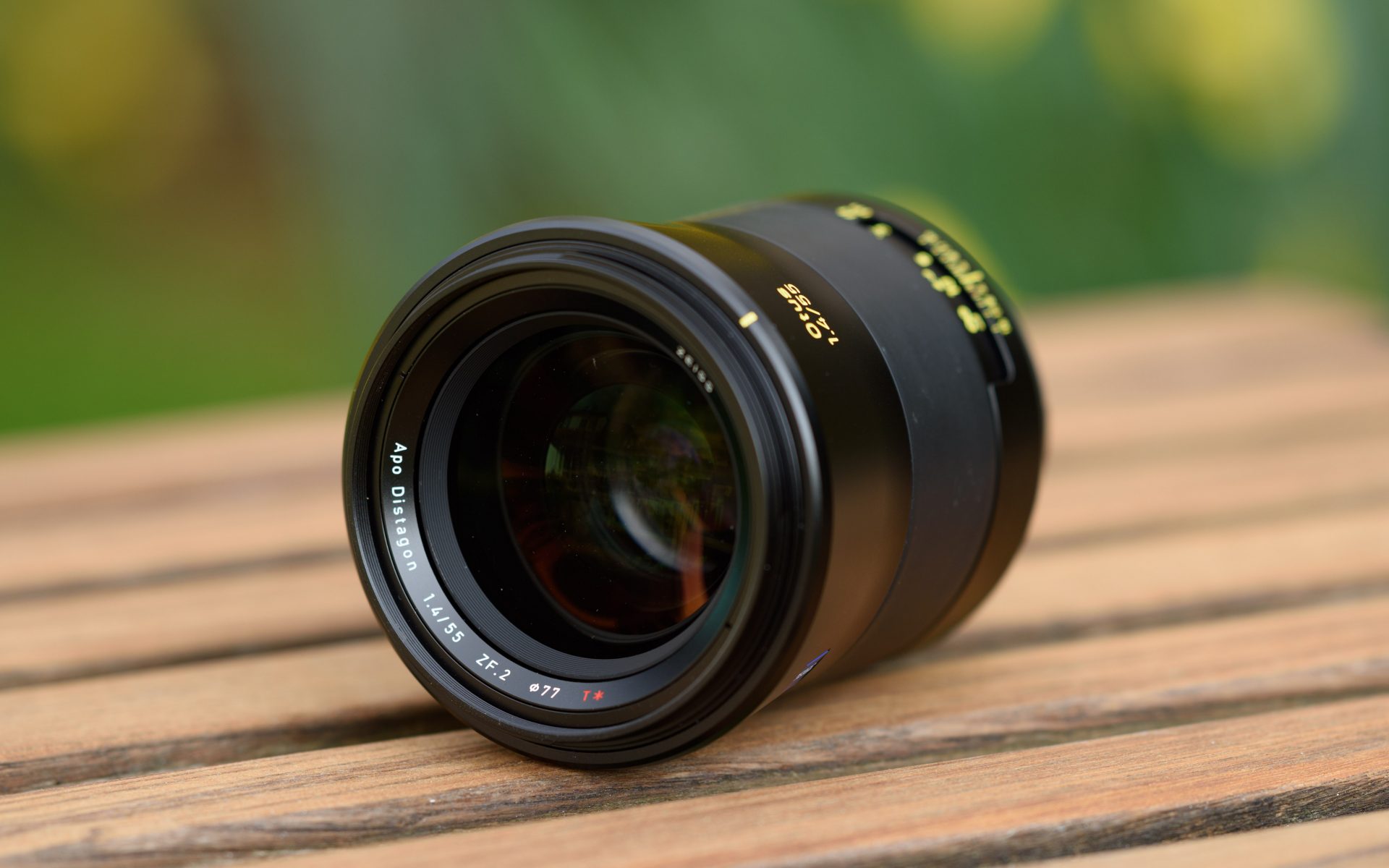
 Good points: Outstanding performance across the frame of a high-resolution full-frame sensor even wide open; excellent build quality. Bad points: Extremely high price; no auto-focus; large and heavy; light fall-off at apertures larger than f2.8; not weather-sealed at the lens mount.
Good points: Outstanding performance across the frame of a high-resolution full-frame sensor even wide open; excellent build quality. Bad points: Extremely high price; no auto-focus; large and heavy; light fall-off at apertures larger than f2.8; not weather-sealed at the lens mount.



